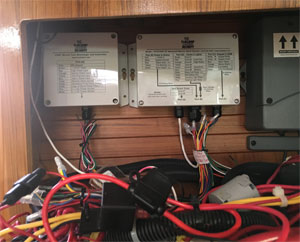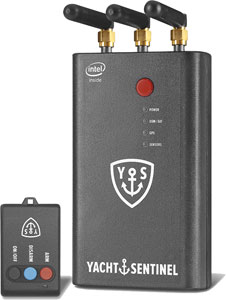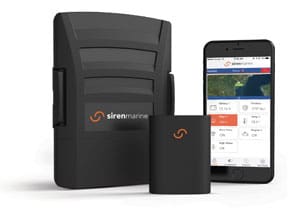Alarm systems come in three basic varieties: stand-alone systems that utilize sound alarms to alert those nearby, cellular network-based systems that can also alert you, and satellite-based systems that can provide worldwide coverage. Most companies offer a combination of local alarms and some type of connectivity, with some products that can utilize both satellite and cellular networks.
You might assume the advantage of satellite systems would only be needed by those voyaging boats that head well offshore, but in reality there are many coastal areas with poor or no cellular data service — as many of us who have cruised the Maine coast or the Bahamas can attest. If your primary needs are in a marina with Wi-Fi and cellular connectivity, however, the advantages of satellite communications may be overkill.
Can you hear me now?
Marine monitoring and alarm company Global Ocean Security Technologies (GOST) utilizes Inmarsat satellites for its communications. Both Yacht Sentinel and Siren Marine primarily use a cellular network but offer the option for Iridium satellite connectivity as well. C-pod and Flagship Marine Security similarly use cellular data networks to communicate with you. MarineGuard by Sure Action Inc. offers alarm options that don’t require any network, or you can choose to have cellular or satellite communications along with GPS tracking. Be sure to check into the cost of hooking up to the required service, which usually will require an annual service plan. Yacht Sentinel, for example, rolls the cost of cellular coverage into its pricing for the first two years. You’ll also want to do some research on the required networks, cellular bands and options for your particular region. You may also consider seeking out some local references for the companies so you can make sure real-world results match up to the marketing, especially if you will be depending on cellular coverage.
Once you’ve made the essential communications choice that suits your needs, you can begin to look at the many security options available. Just like smart home gadgets, most of these units are primarily controlled by smartphone apps that connect to the Internet. Again, this may or may not be good for where you will be located in the world. Even if your boat alarm system has connectivity via satellite, will you be able to get online with a smartphone to monitor things?
 |
|
Flagship Marine Security’s Advanced Marine Alarm System and text messenger/controller units installed on a 42-foot sailboat. |
|
Courtesy Flagship Marine Security |
Most products have the option of control via a remote unit or even a control panel, but the C-pod system relies on your smartphone, while Siren Marine offers monitoring via smartphone, PC or tablet. Is a smartphone or tablet going to work for you when you’re off in a dinghy for a snorkeling expedition or hiking on a remote beach? Whatever control scheme you use, check into backup options for when your phone or remote fails to work. Imagine setting off your own alarm in the middle of the night in a crowded marina with no way to turn things off!
Very sensitive
An important option for many is to be able to install system sensors for things like high water in the bilge or bilge pump activation, smoke alarms and heat alarms. Those of us in northern climes will appreciate that Sweden-based C-pod has low-temperature sensors too.
GOST further expands on these options with a freezer temperature sensor, a high-temperature sensor for the fridge, a power loss sensor and a low-voltage sensor. Both GOST and Siren Marine even offer canvas snap sensors!
Of course, the more sensors you add, the greater the cost. Most companies offer wireless sensors to simplify installation, though wired sensors can be less expensive and more reliable. Siren Marine points out that wired sensors can often be connected directly to existing switches and wiring, such as a bilge pump float switch. They offer both wired and wireless sensors, which can be mixed and matched.
The prevention of theft and intrusion can be handled in different ways. It is possible to have simple magnetic devices that detect the opening of a hatch or door, or you can have motion sensors for down below and on deck. Each company touts the ability of its sensors to avoid false positives when small animals or birds pass by. Sure Action utilizes Pulsor flex sensors for its MarineGuard units; these sensors can detect the flexing movement of the material it is mounted to, such as when people walk on particular places on your decks.
See no evil?
Perhaps the ultimate sensor is a camera system that allows you to remotely take a look and see what is going on before alerting authorities. Yacht Sentinel’s Sentinel Cam allows for 24/7 streaming of 1080p video, which can then be archived for later retrieval if needed. Its small waterproof cameras are designed for low power consumption. GOST Watch HD can similarly stream and record HD video, and you can have up to eight connected cameras. GOST reports that three months of footage can be saved on a 4-terabyte hard drive. Needless to say, data needs and costs can rise quickly when streaming video. Shop carefully, and keep in mind the limitations of cellular and satellite network communications.
Fenced in
GPS tracking options can sometimes be combined with geofencing to limit your boat to a certain area without an alert being sent. In other words, if your boat suddenly leaves its mooring in the middle of the night, you’ll be sent a warning.
GOST reports that insurance discounts may be available for yachts equipped with tracking and system monitoring, and Yacht Sentinel (based in the U.K.) even offers links to insurance discounts directly from its website. Obviously, check with your insurance company first to see what they are looking for in yacht monitoring.
Siren Marine also offers fleet monitoring if that is of interest to you, which uses a cloud-based solution to share information among various parties involved with the fleet.
 |
|
The YS6 unit from Yacht Sentinel. |
|
Courtesy Yacht Sentinel |
More power to you
All of this monitoring, sensing and alarming requires electrical power, which might be in short supply aboard some boats. Real-world consumption figures are not easy to find, though some companies tout their low consumption — Yacht Sentinel claims 30mA for its YS6 system. But what does that include? All the sensors? In general, expect to utilize more power with more sensors and with cellular or satellite connectivity, as well as when alarms are sounding. You will need to make provisions for how to ensure power is always on for the alarm system, even if other boat systems are routinely shut down when leaving the vessel. If shore power and/or other charging means are disconnected, how long can the system run? And what happens to the alarms if your power runs out? If all else fails, it is a good idea to have a hidden master fuse or switch that you can utilize to disarm a blaring alarm and shut down the system.
App happy
Not surprisingly, the apps associated with boat alarms tend to have very few downloads and reviews in Apple’s App Store or on Google Play, though of course you can download and try them out to a limited extent. If your system depends on an app for control, it might be a good idea to consider downloading it on an old phone to be used as backup or on Wi-Fi only, just in case your main phone ends up in the harbor. Just be sure to update the backup phone’s apps once in a while when you are near a good Wi-Fi connection.
Boat alarm systems tend to be as different as they are alike, with each one approaching the problem with a somewhat different perspective. You can begin to make some broad choices by starting with the type of communications you need and from where in the world, then look for the option with the types of sensors you want. Make sure you have the control options you need too, such as a cellphone, web interface, remotes and control panels. I would then seek out local boaters using the system to make sure the whole package works as it should in the marine environment you experience.
John Kettlewell is the author of The Intracoastal Waterway Chartbook and is executive director of Sail Martha’s Vineyard.

